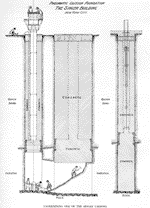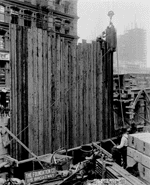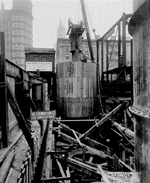|
ENGINEERING HEIGHT
Foundations
Small buildings can sit on footings in ordinary soil, but the concentrated loads at the base of a skyscraper require better support. Manhattan's granite and schist bedrock provides excellent bearing for skyscrapers, but may be located as far down as 100 feet below grade. From around 1890, where bedrock was too far below the ground surface for ordinary footings, piles and caissons were used to transfer loads down to rock. Caissons which are temporary wells used to tunnel vertically to control against cave-ins, allow for deep foundation construction without any excavation except the caissons themselves.
| 
Singer Building, pneumatic caisson section, 1906 | Caissons are constructed using pressurized air to keep out loose material surrounding an opening that has been drilled down to rock. The Singer Building caissons rested on "hardpan"- boulders and bedrock embedded in sand and natural cement. During construction some caissons were undermined by foundation work performed after they were in place. This drawing shows laborers excavating the remaining hardpan, so that the gap between the bottom of the caissons and the bedrock could be filled with concrete.
| 
Woolworth Building, steel sheetpiling, 1911 | Steel sheetpiling was introduced around 1900 to replace wood sheetings. Individual piling sections, two to three feet wide and less than an inch thick, are driven one at a time by the pile driver, seen at the right. The edges interlock to create a continuous surface, so that the sheetpile, working with temporary bracing, allows for excavation without the adjacent earth settling.
| 
American Surety Building, west elevation, foundation section, 1894 | The American Surety Building was the first building in New York City with a complete steel frame supporting both the interior and the exterior masonry. In this drawing, each masonry pier covers a steel column. The columns in the basement, shown without their enclosing foundation walls, rest on a grid of steel grillages which are carried on concrete piers extending down to bedrock. The building also featured one of the first large-scale uses of caissons in New York.
| 
| ||
| < | back | > |